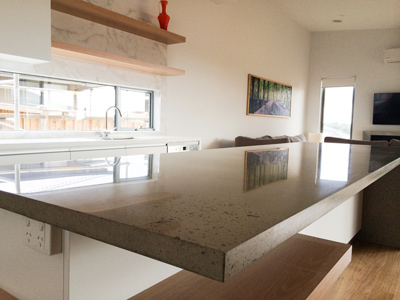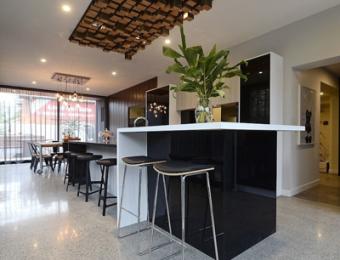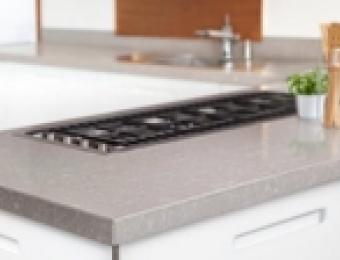
Image courtesy of ConcreteFX
Polished concrete is becoming a much more popular kitchen benchtop choice these days. It can be made and finished in many different ways, both to mimic classic stone-style granite and marble benches – or (more often) in bolder, more stark forms to proudly show off the concrete itself.
Concrete’s especially popular in modern / minimalist / brutalist style kitchens and houses, where the form of the design and the look of the concrete is itself prized as a feature over unnecessary decoration, or less hardy materials.
A polished concrete bench is almost always a bit of a design statement. It’s definitely a superb choice if you’re hoping to inject an ‘industrial’ kind of feel into your kitchen, but there’s nothing to say a kitchen with polished concrete benches can’t also be completely warm, contemporary or comfortable if it’s complemented with the right overall design aesthetic.
How are polished concrete benches made and installed?
How polished concrete benches are made does depend a little on the style you choose. Typically, a formwork mould for the benchtop is built first using a smooth-surfaced material like melamine – precision’s a big deal here, because the nature of concrete means that the bench will come out in the precise shape of the mould.
The mould is likely to include knock-out sections for things like sinks and taps, which will need to go through the bench – they’re easier to mould in than to cut out of a solid slab. Likewise, if you’re after special detailing or designs (including edge bevels) in your bench they’re likely to be incorporated into the mould too, possibly with some type of caulking material.
Depending on the size and shape, the mould may also be split into smaller sections to make it less of an ordeal to lift and install the (potentially extremely heavy) finished product. The benchtop will be the surface at the bottom of the mould – this helps to ensure a nice smooth finish, and to reduce the chance of there being unwanted bubbles or blemishes in the top surface.
There’s a wide range of options when it comes to creating different colours for the concrete, and various dyes and colouring agents can be used to control this. Different types of aggregates can be used to give different textured looks to the concrete too – granite and quartz are popular. Some people may also choose to embed other things into the surface, like seashells, unusual bits of scrap metal or even phosphorescent, glow-in-the-dark type materials.
Once it's prepared to the right consistency, the concrete is poured into the mould, often with a reinforcing mesh set into the middle of it. This is then vibrated vigorously (typically with a mechanical ‘vibrator’ tool or a vibrating table) to allow air bubbles to rise away. Once that’s done, the concrete is left to set - likely for several days - before it’s removed from its moulds and put in place.
Polishing a concrete bench
When the bench has been set and put in place, it’s then ground down and polished using a wet grinder and diamond grinding pads to give it a smooth finish – this part of the process is often done in stages, and may take a week or longer, depending on how it’s done (and who's doing it). A concrete slurry may be used after an initial grinding to fill in small holes on the surface of the benchtop. This will also need a few days to set.
The grit of the diamond pads that are used in polishing determines the smoothness of the finish. The polishing process typically starts with about 50 grit grinding pads, and progressively works upwards, with the finer, higher grit pads removing the scratches from the previous grinding. Grinding pads with a finer grit of 800 and upwards (sometimes up to 3000) give a much smoother, almost mirror-like finish to the benchtop.
Concrete sealer options
Just like stone, concrete’s porous. What that means is that it’ll absorb moisture, and that some substances may leave a stain. You’ll normally need to apply some kind of concrete sealer - or a combination of sealers - to the benchtop to protect it from stains, heat damage and scratches. At the same time, it’s also important to consider:
- how ‘safe’ the particular concrete sealer you’re intending to use is - especially given that this is where you’ll prepare food,
- how it might change colour over time, and
- how regularly it’ll need to be maintained.
Options for finishes include:
- topical sealers - these are applied to the surface of the concrete to cover and protect it, and are usually more appropriate for kitchen benchtops.
- penetrating sealers - as you’d expect, these penetrate the surface of the concrete, and are usually classified as either ‘densifiers’ or ‘repellants’ (often used in tandem, with the densifier applied before polishing and the repellant after). Penetrating sealers have come a long way in recent years, and different products will perform very differently.
Below is a table with a bit more information about the relative benefits and drawbacks of different sealer options. The information it contains is a little subjective - it's worth knowing that the choice of sealers, the quality of the particular product you've chosen, and the skill with which it's applied can make a huge difference. Talk to your supplier and do your homework to find out which option’s best for you:
| Type | Stain-resistant | Heat resistant | Scratch resistant | Sheen | UV stable | Easy to apply | Easy to care for / repair | Other comments |
|---|---|---|---|---|---|---|---|---|
| Penetrating
Densifiers:
Repellants:
|
Varies with products | Yes | Yes | Sheen and colour vary | Yes | Depends on which is used | Yes | Once repellants are applied, wax is usually the only sealer that can be used. |
| Wax | No | No | No | Natural medium to high sheen | Yes | Yes | Yes | Must be reapplied fairly often |
| Acrylic
(solvent or water based) |
Slightly | Slightly | No | Solvent- based: wets out
Water-based: dry look |
Yes | Yes | Solvent-based: yes
Water-based: no |
Easily scratched, may need to be repaired often |
| Epoxy
|
Yes | No | No | Glossy and thick | No | No | No | Looks a little it's coated in plastic |
| Urethane
|
Yes | Yes | Yes | Normally glossy, but matte options do exist.
Typically thick, but possible to apply thinly |
Yes | No | No | Difficult to apply, heavily depends on surface prep. |
| Source: Sealer Options for Concrete Countertops By Jeffrey Girard, P.E., President, The Concrete Countertop Institute (last viewed 3/7/14) | ||||||||
What are the properties of polished concrete benches?
It should probably go without saying, but concrete’s extremely tough and should take most of the abuse it’s likely to ever experience in a kitchen without any serious risk of damage.
It’s also notoriously heavy, which means that if you’ve got a stump subfloor you may need specially engineered supports to help retain its weight – and depending on how thick it is, you’ll probably need special supports to help keep it from causing damage to your cabinets. Polished concrete benchtops sometimes incorporate concrete end supports too, both as a way to complete the look, and to ensure that the bench is nice and sturdy.
Like stone, polished concrete’s porous, and is susceptible to scratches, and to staining and etching from things like acids and oils. The sealants you use, how quickly you clean up spills and how regularly you maintain your bench will determine how resilient it is to those things. Some sealants might also change colour with exposure to UV light.
And while some sealants will provide some level of heat resistance, as a rule it's always best to assume you shouldn't put very hot or cold objects on a concrete benchtop. Like most natural and engineered stone options, polished concrete will always be susceptible to thermal shock.
How much do concrete benchtops cost?
Price-wise, you’ll probably pay more for a polished concrete kitchen benchtop than you will for cheaper options like laminate, and maybe slightly more than you will for engineered stone (like Caesarstone) but this is mostly because of the labour that goes into making it and the cost of the grinding pads. The materials themselves are fairly inexpensive, and polished concrete is likely to be affordable when you compare it to expensive natural stones like marble and granite.
DIY is an option, but be warned that there’s a steep learning curve, and quite a few different points where things can go terribly wrong. Benches made by professionals will be far better than anything you’re able to put together yourself.
- If you're shopping around, make sure you check out examples of previous work. Not all polished concrete specialists have the same skills or work to the same standards.
Maintenance for concrete benchtops
The maintenance your bench will need will depend mostly on the sealants you’ve chosen to use. Wax is very popular and looks great, but it’ll need to be reapplied once in a while. Other sealants will probably need less attention, but provide different looks and properties.
Polished concrete can also be cleaned with pH-neutral cleaners designed for natural and engineered stone surfaces. Acidic cleaners should be avoided - they may etch the surface of the concrete.
|
Advantages
|
Disadvantages
|




